Kelvin Thomson
Planning Democracy Report No.50 - April 15, 2025
Video: Australia’s Population Ponzi Scheme by Kelvin Thomson
Planning Democracy Report No 49 - March 16, 2025
Planning Democracy Report No.48 - February 26, 2025
Planning Democracy Report No.47, Janurary 29, 2025
Planning Democracy Report No.46 - December 14, 2024
Planning Democracy Report No.45 - November 17, 2024
Planning Democracy Report No.44 - October 12, 2024
Planning Democracy Report No.43 - September 7, 2024
Planning Democracy Report No.42 - August 6, 2024
Planning Democracy Report No.41 - July 12, 2024
Planning Democracy Report No.40 - June 2023
Planning Democracy Report No 39, June 5, 2024
Planning Democracy Convenor's Report No. 38 - May 16, 2024
Liveable Victoria Manifesto Launch Invitation - 24 September 2023 - East Melbourne
 Planning Democracy, and the Green Wedges Coalition Inc., are pleased to invite you to the launch of the Liveable Victoria Manifesto.
Planning Democracy, and the Green Wedges Coalition Inc., are pleased to invite you to the launch of the Liveable Victoria Manifesto.
The Manifesto is intended to protect Victoria from overdevelopment at the hands of increasingly aggressive and greedy property developer interests. It seeks to safeguard our
residential and enviromental amenity, heritage, tree canopy cover, Green Wedges, and open space.
Stop the Great Wall of Frankston - Minister intervenes
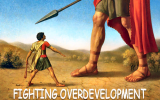 There is exciting news from Frankston. On Wednesday Victorian Planning Minister Sonya Kilkenny announced an Interim Design and Development Overlay which included mandatory height limits of 3 storeys on the section of land between Kananook Creek Boulevard and Nepean Highway.
There is exciting news from Frankston. On Wednesday Victorian Planning Minister Sonya Kilkenny announced an Interim Design and Development Overlay which included mandatory height limits of 3 storeys on the section of land between Kananook Creek Boulevard and Nepean Highway.
Text & Video Kelvin Thomson's speech at the Stop the Great Wall of Frankston Rally 13 May 2023
Planning Democracy Convenor's Report No. 25 - April 29, 2023
Click on the image to read Report No. 24. which is linked in pdf form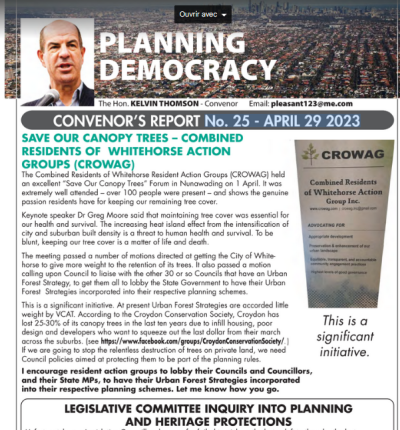
Planning Democracy Convenor's Report No.24 - March 21, 2023
 Where To From Here - Victorian Local Government Elections 2024; Save Our Canopy Trees – April 1 Forum; Planning and Heritage Inquiry; Level Crossing Removal FOI; VCAT Protest?; Let There Be Light – Brunswick Residents Have a Win; Planning Scheme Amendment St Phillip St Brunswick East; Guest Speaker at Fitzroy Residents Association; John Curtin Hotel; Royal Exhibition Building and Carlton Gardens; Western Port Woodlands Alliance Formed; MAB Attempts to Silence Westmeadows Re
Where To From Here - Victorian Local Government Elections 2024; Save Our Canopy Trees – April 1 Forum; Planning and Heritage Inquiry; Level Crossing Removal FOI; VCAT Protest?; Let There Be Light – Brunswick Residents Have a Win; Planning Scheme Amendment St Phillip St Brunswick East; Guest Speaker at Fitzroy Residents Association; John Curtin Hotel; Royal Exhibition Building and Carlton Gardens; Western Port Woodlands Alliance Formed; MAB Attempts to Silence Westmeadows Re
Planning Democracy Convenor's Report No 23
 Contents: Page 1 – Heritage Amendment Bill 2023; Victorian Departmental Restructure; Australian Architecture President Bells the Cat; Legislative Council Planning and Heritage Inquiry; Page 2 – Submissions Closing on World Heritage Management Plan for Royal Exhibition Building and Carlton Gardens; Speech to CROWAG, and April Forum; Level Crossing Removal FOI; War on Plastic – Clean Up Australia Day; Page 3 – South Australia’s Planning Minister Flags Change
Contents: Page 1 – Heritage Amendment Bill 2023; Victorian Departmental Restructure; Australian Architecture President Bells the Cat; Legislative Council Planning and Heritage Inquiry; Page 2 – Submissions Closing on World Heritage Management Plan for Royal Exhibition Building and Carlton Gardens; Speech to CROWAG, and April Forum; Level Crossing Removal FOI; War on Plastic – Clean Up Australia Day; Page 3 – South Australia’s Planning Minister Flags Change
Submission on the Revised Draft of the World Heritage Management Plan for the Royal Exhibition Building and Carlton Gardens
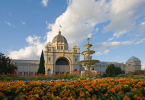 I appreciate the opportunity for public comment on this important issue. I was the Federal Shadow Minister for Environment and Heritage when the then Federal Minister for Environment and Heritage announced the move to nominate the Royal Exhibition Building and Carlton Gardens for World Heritage listing. I have followed the history of this site with considerable interest.
I appreciate the opportunity for public comment on this important issue. I was the Federal Shadow Minister for Environment and Heritage when the then Federal Minister for Environment and Heritage announced the move to nominate the Royal Exhibition Building and Carlton Gardens for World Heritage listing. I have followed the history of this site with considerable interest.
Protecting democracy and public amenity
 Presentation by The Hon. Kelvin Thomson, Convenor of Planning Democracy, to Combined Residents of Whitehorse Action Groups, (CROWAG) Wednesday 15 February, Blackburn Lake Visitor Centre.
Presentation by The Hon. Kelvin Thomson, Convenor of Planning Democracy, to Combined Residents of Whitehorse Action Groups, (CROWAG) Wednesday 15 February, Blackburn Lake Visitor Centre.
Planning Democracy Convenor's Report No.22 - February 2023
 In this issue: Victorian Parliament Resumes; Protecting Democracy and Amenity – 15 February Blackburn Speech; Facebook Page; Save Lake Knox; Ryman Healthcare; Mount Eliza Development; CROWAG April Public Forum – Save Our Canopy Trees; Stop the Great Wall of Frankston; Long Reserve Langwarrin; Concrete coming out of the Moonee Ponds Creek; War on Plastic; Kilmore Land Upda
In this issue: Victorian Parliament Resumes; Protecting Democracy and Amenity – 15 February Blackburn Speech; Facebook Page; Save Lake Knox; Ryman Healthcare; Mount Eliza Development; CROWAG April Public Forum – Save Our Canopy Trees; Stop the Great Wall of Frankston; Long Reserve Langwarrin; Concrete coming out of the Moonee Ponds Creek; War on Plastic; Kilmore Land Upda
Planning Democracy Convenor's Report No 21 – January 17, 2023.
 In this issue: 1.WELCOME TO 2023; 2.VCAT DELAYS; 3.STOP THE GREAT WALL OF FRANKSTON; 4.SUNBURY HIGH RISE TO GO TO VCAT; 5.KILMORE BUSHFIRE EVACUATION ISSUE; 6.BAD NEWS ON THE MORNINGTON PENINSULA; 7. KINGSWOOD GOLF COURSE; 8.477 SYDNEY RD. COBURG – BIKE SPACES, BUT NO CARS PLEASE; 9. PLANNING DEMOCRACY FACEBOOK PAGE; 10. WORLD HERITAGE MANAGEMENT PLAN OVERVIEW; 11.
In this issue: 1.WELCOME TO 2023; 2.VCAT DELAYS; 3.STOP THE GREAT WALL OF FRANKSTON; 4.SUNBURY HIGH RISE TO GO TO VCAT; 5.KILMORE BUSHFIRE EVACUATION ISSUE; 6.BAD NEWS ON THE MORNINGTON PENINSULA; 7. KINGSWOOD GOLF COURSE; 8.477 SYDNEY RD. COBURG – BIKE SPACES, BUT NO CARS PLEASE; 9. PLANNING DEMOCRACY FACEBOOK PAGE; 10. WORLD HERITAGE MANAGEMENT PLAN OVERVIEW; 11.
About Planning Democracy - Speech by the Hon. Kelvin Thomson to Protectors of Public Lands AGM 19 November 2022
 "It is important that we fight. The stakes are high. Urbanisation has become like tobacco and fossil fuels. A lot has been written about the dark arts employed by the tobacco companies and their lobbyists, and the fossil fuel companies and their lobbyists, to muddy the waters and prevent the public from understanding the damage their products do to public health and to the environment.
"It is important that we fight. The stakes are high. Urbanisation has become like tobacco and fossil fuels. A lot has been written about the dark arts employed by the tobacco companies and their lobbyists, and the fossil fuel companies and their lobbyists, to muddy the waters and prevent the public from understanding the damage their products do to public health and to the environment.
Planning Democracy Convenor’s Report No. 20, December 19, 2022
 In this issue: VICTORIAN ELECTION FOLLOW-UP; HUME COUNCIL APPROVES FIVE STOREY DEVELOPMENT IN SUNBURY; RYMAN HEALTH 6 STOREY APPLICATION NOW BEFORE MOONEE VALLEY COUNCIL; CROWAG 2023 TREE COVER FORUM; CROYDON CONSERVATION SOCIETY UPDATE; GOOD NEWS 1.
In this issue: VICTORIAN ELECTION FOLLOW-UP; HUME COUNCIL APPROVES FIVE STOREY DEVELOPMENT IN SUNBURY; RYMAN HEALTH 6 STOREY APPLICATION NOW BEFORE MOONEE VALLEY COUNCIL; CROWAG 2023 TREE COVER FORUM; CROYDON CONSERVATION SOCIETY UPDATE; GOOD NEWS 1.
Planning Democracy Convenor's Report No 19 – December 4, 2022
 In this issue: VICTORIAN ELECTION; CLIFFORD HAYES NOT RE-ELECTED TO LEGISLATIVE COUNCIL; LESSONS FROM THE ELECTION FOR PLANNING DEMOCRACY; SPEECH TO PROTECTORS OF PUBLIC LANDS AGM; SPEECH TO NORTH EAST LINK RALLY; WIN OVER VICSMART CRAZINESS; MIAMI HOTEL WEST MELBOURNE – DEVELOPERS BEHAVING BADLY; RESIDENTS SAY IN PLANNING – MICHAEL BUXTON; RESIDENTS SAY IN PLANNING – CITY OF MELBOURNE CONSULTATION RULES; SAVE WESTERNPORT WOODLANDS; PROTECTING NATIONAL PARKS FROM OVERDEVELOP
In this issue: VICTORIAN ELECTION; CLIFFORD HAYES NOT RE-ELECTED TO LEGISLATIVE COUNCIL; LESSONS FROM THE ELECTION FOR PLANNING DEMOCRACY; SPEECH TO PROTECTORS OF PUBLIC LANDS AGM; SPEECH TO NORTH EAST LINK RALLY; WIN OVER VICSMART CRAZINESS; MIAMI HOTEL WEST MELBOURNE – DEVELOPERS BEHAVING BADLY; RESIDENTS SAY IN PLANNING – MICHAEL BUXTON; RESIDENTS SAY IN PLANNING – CITY OF MELBOURNE CONSULTATION RULES; SAVE WESTERNPORT WOODLANDS; PROTECTING NATIONAL PARKS FROM OVERDEVELOP
Planning Democracy Convenor's Report No.18, November 8, 2022
Planning Democracy Convenor's Report No.17 - October 18 2022
 This edition's headlines: Pre-Election forum; State Election Questionnaire Responses; Floods; Queen Victoria Market; A win at Oaklands Junction; Saving Mount Eliza's reservoir as a public wetland; Royal Exhibtion Building and Carlton Gardens; Kilmore's Equine Overlay; Beaumaris Modern Open Day; Kingston Planning Scheme Amendment C203; Hepburn Shire Biodiversity Threat; Toondah Harbour - Walker Corporation; Save Westesrn Port Woodlands; Caring for Western Port Country; Value
This edition's headlines: Pre-Election forum; State Election Questionnaire Responses; Floods; Queen Victoria Market; A win at Oaklands Junction; Saving Mount Eliza's reservoir as a public wetland; Royal Exhibtion Building and Carlton Gardens; Kilmore's Equine Overlay; Beaumaris Modern Open Day; Kingston Planning Scheme Amendment C203; Hepburn Shire Biodiversity Threat; Toondah Harbour - Walker Corporation; Save Westesrn Port Woodlands; Caring for Western Port Country; Value






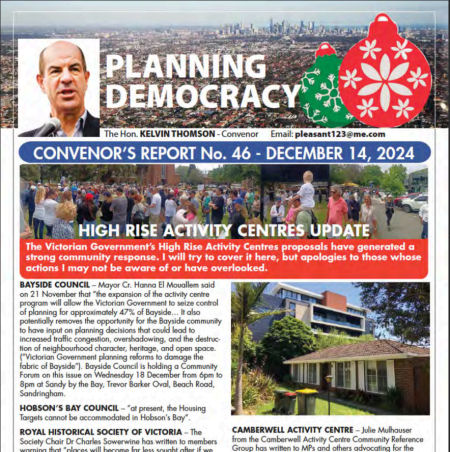

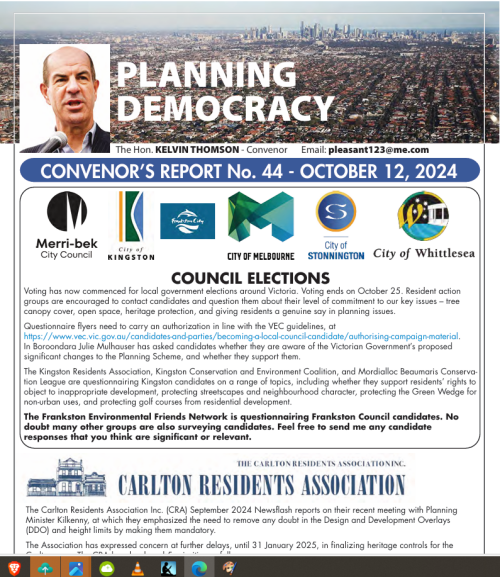





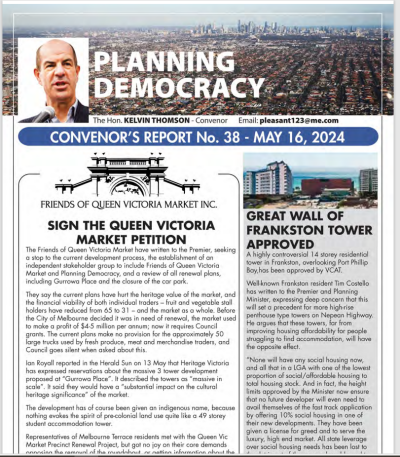

Recent comments